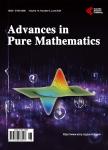A New Proof for Congruent Number’s Problem via Pythagorician Divisors
A New Proof for Congruent Number’s Problem via Pythagorician Divisors作者机构:UFR Mathematics and Computer Science Félix Houphouët Boigny University Abidjan Cote d’Ivoire
出 版 物:《Advances in Pure Mathematics》 (理论数学进展(英文))
年 卷 期:2024年第14卷第4期
页 面:283-302页
学科分类:07[理学] 0701[理学-数学] 070101[理学-基础数学]
主 题:Prime Numbers-Diophantine Equations of Degree 2 & 4 Factorization Greater Common Divisor Pythagoras Equation Pythagorician Triplets Congruent Numbers Inductive Demonstration Method Infinite Descent BSD Conjecture
摘 要:Considering Pythagorician divisors theory which leads to a new parameterization, for Pythagorician triplets ( a,b,c )∈ ℕ 3∗ , we give a new proof of the well-known problem of these particular squareless numbers n∈ ℕ ∗ , called congruent numbers, characterized by the fact that there exists a right-angled triangle with rational sides: ( A α ) 2 + ( B β ) 2 = ( C γ ) 2 , such that its area Δ= 1 2 A α B β =n;or in an equivalent way, to that of the existence of numbers U 2 , V 2 , W 2 ∈ ℚ 2∗ that are in an arithmetic progression of reason n;Problem equivalent to the existence of: ( a,b,c )∈ ℕ 3∗ prime in pairs, and f∈ ℕ ∗ , such that: ( a−b 2f ) 2 , ( c 2f ) 2 , ( a+b 2f ) 2 are in an arithmetic progression of reason n;And this problem is also equivalent to that of the existence of a non-trivial primitive integer right-angled triangle: a 2 + b 2 = c 2 , such that its area Δ= 1 2 ab=n f 2 , where f∈ ℕ ∗ , and this last equation can be written as follows, when using Pythagorician divisors: (1) Δ= 1 2 ab= 2 S−1 d e ¯ ( d+ 2 S−1 e ¯ )( d+ 2 S e ¯ )=n f 2;Where ( d, e ¯ )∈ ( 2ℕ+1 ) 2 such that gcd( d, e ¯ )=1 and S∈ ℕ ∗ , where 2 S−1 , d, e ¯ , d+ 2 S−1 e ¯ , d+ 2 S e ¯ , are pairwise prime quantities (these parameters are coming from Pythagorician divisors). When n=1 , it is the case of the famous impossible problem of the integer right-angled triangle area to be a square, solved by Fermat at his time, by his famous method of infinite descent. We propose in this article a new direct proof for the numbers n=1 (resp. n=2 ) to be non-congruent numbers, based on an particular induction method of resolution of Equation (1) (note that this method is efficient too for general case of prime numbers n=p≡a ( ( mod8 ) , gcd( a,8 )=1 ). To prove it, we use a classical proof by induction on k , that shows the non-solvability property of any of the following systems ( t=0 , corresponding to case n=1 (resp. t=1 , corresponding to case n=2 )): ( Ξ t,k ){ X 2 + 2 t ( 2 k Y ) 2 = Z 2 X 2 + 2



